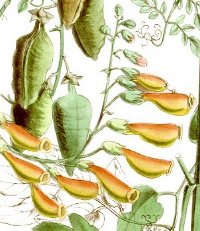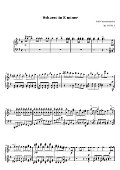Scherzo in E Minor
This piece for piano is a delightful composition by the young Mendelssohn, made all the more special by the story connected with it. I have typeset an edition of the music, which is freely available below.
About the piece...
Mendelssohn composed this Scherzo for Honora, the youngest daughter of John Taylor, a wealthy lead-mine owner and patron of the arts with whom he stayed whilst on holiday in 1819. He stayed with the Taylor family at their rented country residence, Coed Du (Black Wood), near Rhydymwyn in Flintshire, North Wales.
(See also: letters written about the stay)
Mendelssohn was captivated by the charm and beauty of Taylor's three daughters, Anne, Honora and Susan, and spent much of his time sketching and flirting with them whilst he was in Wales. He also composed a short piano piece for each of them, making up his Trois Fantasias ou Caprices, Op. 16, in which he transformed Welsh impressions into character pieces.
The second of these, a Scherzo written for Honora, has proved the most popular and enduring of the three pieces. It was inspired, according to one of Anne's letters, by a creeping vine bearing trumpet-shaped flowers which grew in the family's garden (Eccremocarpus scaber). Honora, who listened to Mendelssohn's playing in wide-eyed wonder, plaited the yellow flowers in her hair, and asked of him "Could you not compose music for such lovely trumpets?" "Certainly," replied Mendelssohn, "the fairies might have played on such instruments."

Image source: Wikipedia
See also this image.
Mendelssohn, who was accomplished at drawing and painting, decorated the margin of the autograph manuscript with a watercolour sketch of a branch of the vine. The light and airy music in the scherzo is not unlike that of A Midsummer Night's Dream, for which he composed the overture two years earlier, aged 18. In 1939, this piece was used to accompany Toto's escape from the Witch of the West in the American cultural icon The Wizard of Oz.
The first of the three pieces, written for Anne, depicted a bunch of carnations (his favourite flower) and roses, and had rising arpeggios to suggest the wafting scent. The third piece, for Susan (the 'prettiest' daughter), traced a meandering stream beside which Mendelssohn had sketched with the girls, and is entitled The Rivulet.
This edition
After a fruitless search to find a free copy of the music online, which only turned up first and last "sample pages", I finally found an old edition at the IMSLP / Petrucci Music Library.
However, though this version is adequate, I was still frustrated by the lack of a copy of the music in the public domain which is not simply a scan, and so I determined to typeset my own copy. Also, I just wanted the Scherzo, and not the other two pieces.
I investigated the options for music typesetting via free and open source software, and initially invetigated MusiXTeX (which is recommended at the Werner Icking music archive). In the end, though, I found the learning curve rather too steep, and opted for lilypond instead, after perusing their website, with which I was quite impressed (see particularly the essay on engraving). Lilypond is used at the Mutopia project, an excellent source of free online sheet music.
PDF:
Lilypond source: scherzo.ly
The resulting edition, closely based on the version obtained from IMSLP, is above. After using lilypond to produce this, I cannot praise it highly enough. It is an excellent piece of software, and those familiar with the rudiments of any markup language such as LaTeX or html will easily pick it up.
If you have any comments or suggestions about the score - or if you spot any mistakes! - please get in touch (contact details at the bottom of the contents page).
References
Mendelssohn R. Larry Todd, OUP, 2005
Scherzo in E minor Alfred Publishing, 1988

